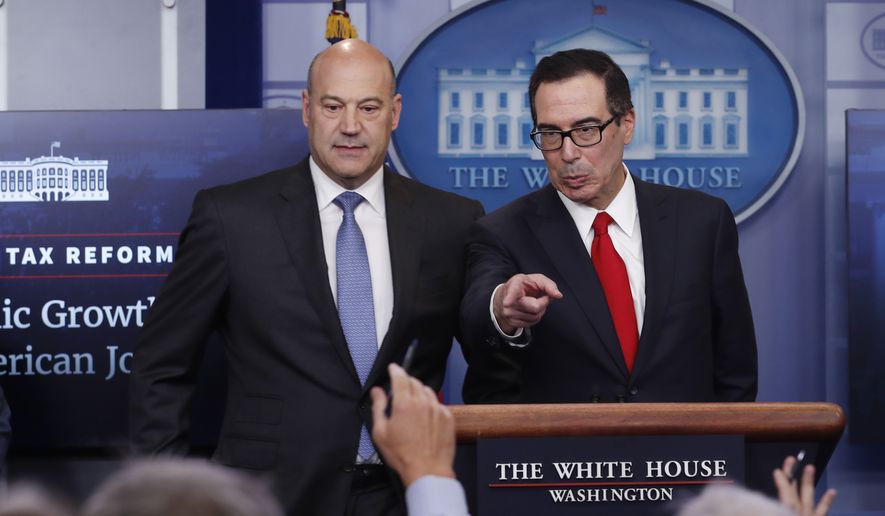The White House announced the outlines of an ambitious tax reform plan Wednesday that envisions deep cuts in the rates paid by American families and businesses — and top aides warned naysayers against doubting President Trump’s ability to get it done.
Mr. Trump’s economics team said the blueprint would reduce most Americans’ tax filing to a single page, make businesses more competitive in the international economy and entice trillions of dollars of investment back into the U.S.
“It’s a great plan. It’s going to put people back to work,” Mr. Trump said.
The outline won immediate praise from the Republicans who will have to shepherd the plan through Capitol Hill, and from business groups that said the country is long overdue for a simpler, more competitive tax code.
But Democratic leaders and budget watchdog groups said the outline was short on details, predicted the numbers wouldn’t add up and warned of ever-deepening deficits as money is siphoned away from the Treasury.
“If the president’s plan is to give a massive tax break to the very wealthy in this country — a plan that will mostly benefit people and businesses like President Trump’s — that won’t pass muster with we Democrats,” said Senate Minority Leader Charles E. Schumer, New York Democrat.
Mr. Trump laid out four goals for reforms, which his aides said will shape the debate as Congress works to fill in the details. He wants a plan that expands the economy and creates millions of jobs, simplifies the burdensome tax code, provides relief to American families, especially in the middle class, and establishes one of the lowest business tax rates on the globe.
His plan would flatten the tax code by reducing the number of tax brackets from seven to three. He would lower the top tax rate from 39.6 percent to 35 percent, and the other brackets would have rates of 25 percent and 10 percent.
The standard deduction would more than double to $24,000 for a married couple, essentially creating a 0 percent rate for low-income families.
Mr. Trump would eliminate every tax deduction except those that are most popular among middle-class families: the home mortgage interest and charitable giving breaks.
The estate tax would be eliminated, as would the alternative minimum tax for high earners and Obamacare’s 3.8 percent tax on investment income.
On the business side, the plan calls for reducing the corporate tax rate from 35 percent to 15 percent.
“This is a once-in-a-generation opportunity to do something really big,” said Gary Cohn, director of the president’s National Economic Council, who presented the plan to reporters at the White House and acknowledged the fight ahead.
“We will be attacked from the left, and we will be attacked from the right. But one thing is certain: I would never, ever bet against this president. He will get this done for the American people,” Mr. Cohn said.
The proposal also included a one-time opportunity for corporations to bring offshore profits into the U.S. at a lower rate than the current 35 percent. The proposal did not specify what the lower rate would be, but the tax break promises a massive surge in revenue.
U.S. companies hold an estimated $2.6 billion offshore to avoid high tax rates.
The plan did not include the border adjustment tax that House Republicans had sought as a way to rebalance incentives between imports and exports and to raise the money needed to offset the rate cuts.
Critics said the huge tax cuts for individuals and businesses threatened to increase deficits. The 15 percent corporate tax rate alone, they estimated, would cost the government $2 trillion in lost revenue.
Treasury Secretary Steve Mnuchin said those projections ignored the economic growth that the lower rates would spur, generating more revenue for the government — “trillions of dollars,” he said.
“Hogwash,” replied Taxpayers for Common Sense, a budget watchdog. “Growth is the magic pixie dust policymakers throw in economic plans to make them appear fiscally sound when they aren’t. Before you know it, poof, that pixie dust turns into a pile of deficit spending that adds to the nation’s soaring debt.”
The debate about whether tax cuts “pay for themselves” is likely to dominate the conversation, but Democrats also are using labels such as “immoral” and “unprincipled.”
“While the president, multinational corporations and wealthy shareholders enjoy a big tax cut, trillions of dollars will be added to America’s crippling debt,” said Sen. Ron Wyden of Oregon, the top Democrat on the Senate Finance Committee. “This kind of irresponsibility is light on details for people who work for a living and is based off of a failed trickle-down economic theory and one that could deplete Medicare and Social Security as we know it.”
Republican leaders on Capitol Hill, who intend to put their mark on a tax reform bill, called Mr. Trump’s plan “critical guideposts” for the legislative process while endorsing the precept of lower rates for individuals and businesses.
“With an eye toward fairness and simplicity, we’re confident we can rebuild our tax code in a way that will grow our economy, better promote savings and investment, provide our job creators with a competitive advantage, and bring prosperity to all Americans,” Republican leaders said a joint statement.
The statement was issued by House Speaker Paul D. Ryan of Wisconsin, Senate Majority Leader Mitch McConnell of Kentucky, House Ways and Means Committee Chairman Kevin Brady of Texas and Senate Finance Committee Chairman Orrin G. Hatch of Utah.
Rep. Tom Cole, Oklahoma Republican, said communication between the White House and Congress is “good and getting better.”
“And look, he’s the president of the United States — he has every right to make any [proposal] he cares to make,” he said.
Mr. Cole said he didn’t necessarily view House Republicans’ proposed border adjustment tax on imports as “dead.”
“But clearly, if you don’t proceed under reconciliation, you don’t have to have it,” he said. “And I’m not saying that’s a good thing [because] I’m very worried about blowing huge holes in the deficit, but this does provide more flexibility.”
The plan quickly gained plaudits from business groups.
“President Trump has listened to those who feel they work harder today for less or are out of a job,” said Jay Timmons, president and CEO of the National Association of Manufacturers. “The president delivered on his commitment to put the force of the White House behind policies that will grow the manufacturing economy in the United States and raise standards of living for everyone in our country.”
Matthew Shay, president and CEO of the National Retail Federation, commended Mr. Trump’s “leadership on much-needed comprehensive tax reform.”
“What matters most is that we enact pro-growth tax policy for both individuals and businesses. This puts money back in the pockets of hardworking Americans, helping to grow businesses and industries in the communities where consumers live and work,” he said.
• David Sherfinski contributed to this report.
• S.A. Miller can be reached at smiller@washingtontimes.com.




Please read our comment policy before commenting.